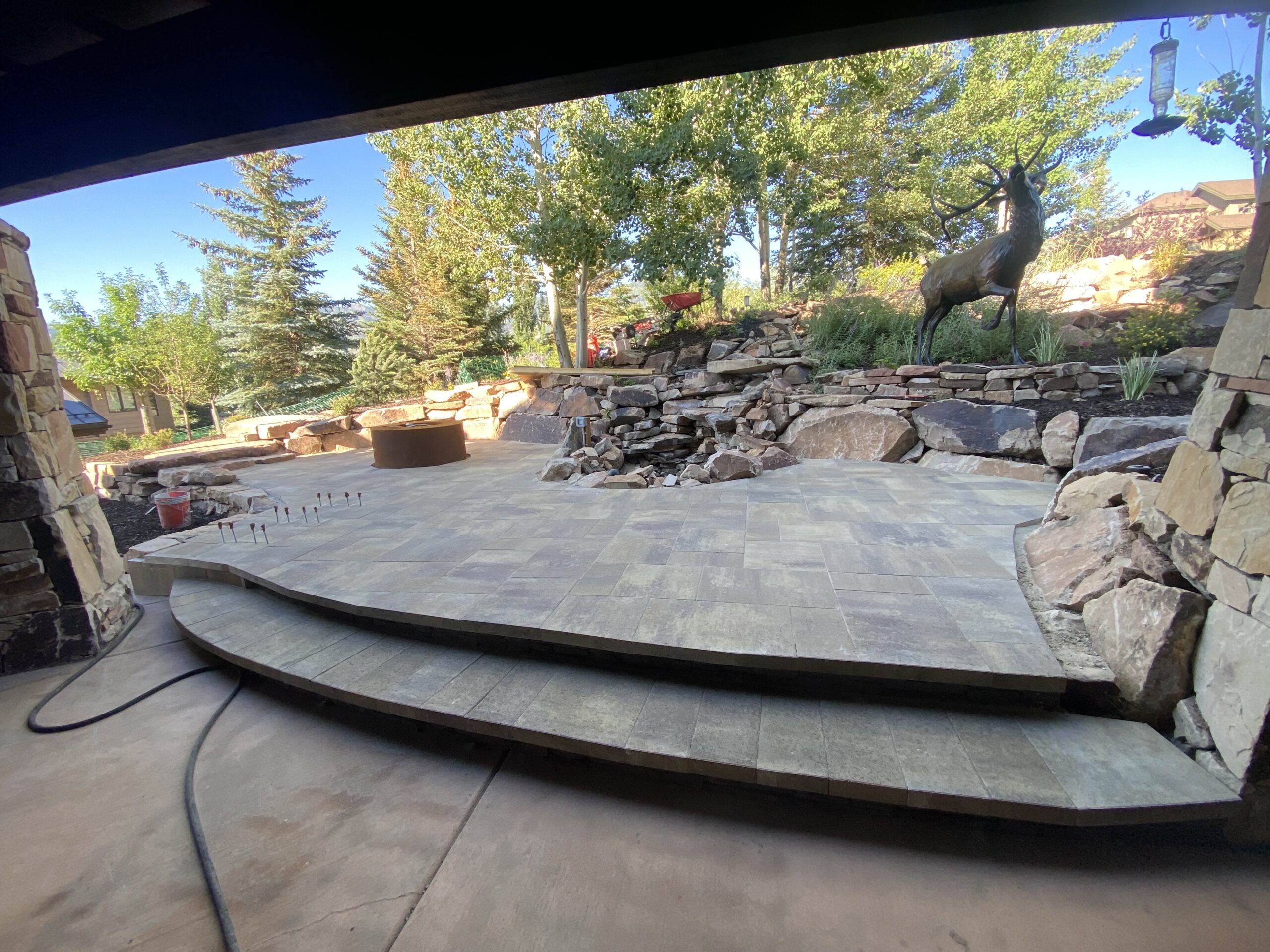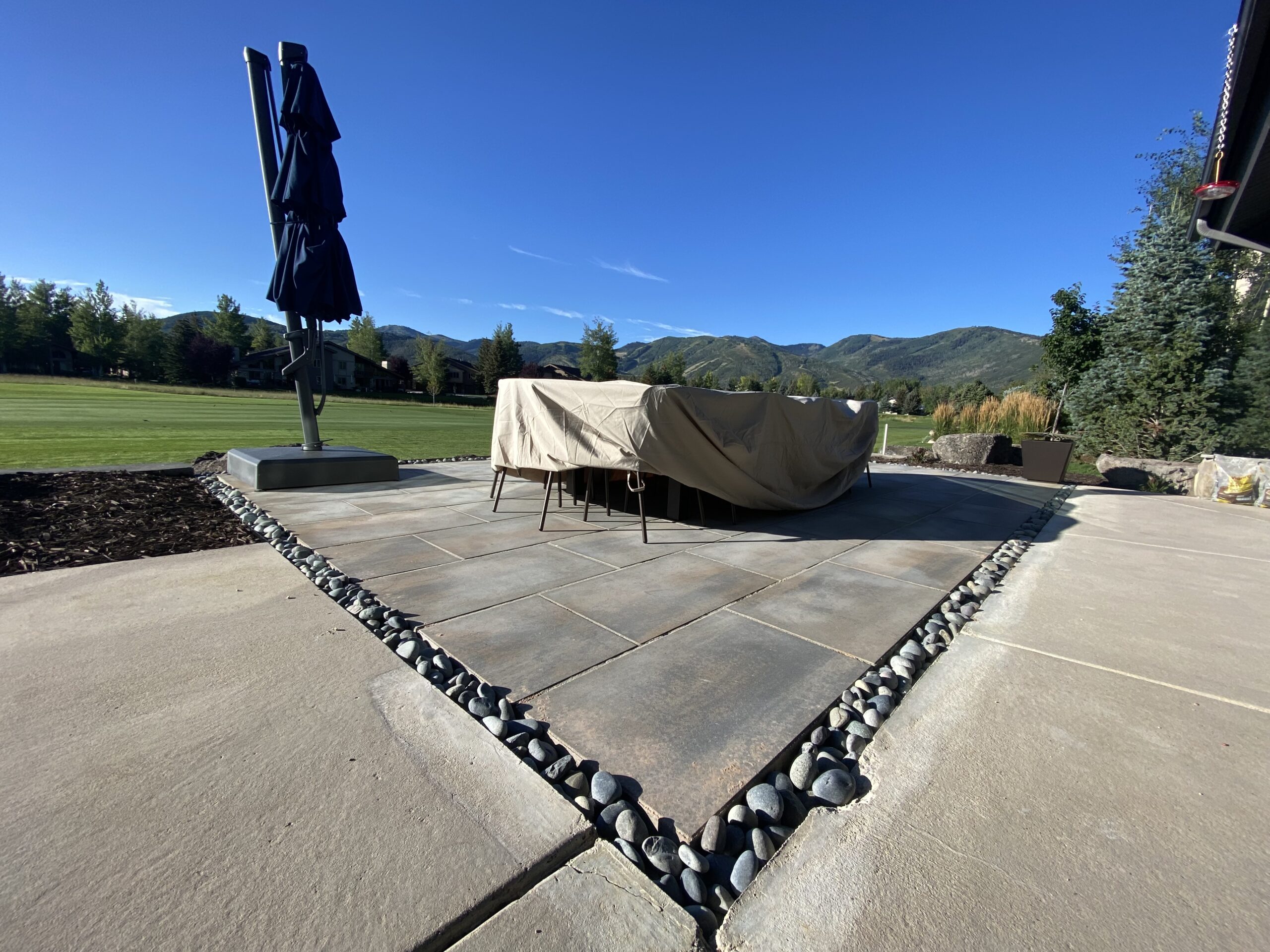Heated pavers and heated concrete are high-end solutions for maintaining hardscape surfaces during cold and wet weather. These systems offer a practical approach to keeping walkways, driveways, and patios free from snow and ice, enhancing safety and usability throughout the winter months.
Heated Pavers in Park City
Living in the beautiful mountain landscape of Park City, Utah, means coping with the various challenges its winters present. Homeowners and businesses alike are turning to innovative solutions for their outdoor surfaces. Among these, heated outdoor surfaces have emerged as a popular choice for driveways, walkways, and patios. This blog post delves into the benefits of heated outdoor surfaces and compares two prominent options: heated pavers and heated concrete, focusing on their cost differences, and nuances in construction, maintenance, and repair.

Benefits of Heated Outdoor Surfaces
Heated outdoor surfaces offer an array of advantages, particularly in regions prone to snow and ice. Firstly, they significantly reduce the need for manual snow removal and the application of de-icing chemicals, which can be labor-intensive and environmentally harmful. By maintaining a snow-free surface, they also greatly decrease the risk of slip-and-fall accidents, ensuring safer pedestrian and vehicle movement. Furthermore, these systems can prolong the lifespan of the surface material by preventing freeze-thaw cycles that cause cracking and damage over time.
The addition of heated elements beneath outdoor surfaces not only enhances safety and convenience but also adds a luxurious element to property amenities. This technological advancement ensures that outdoor areas remain functional and welcoming, even during the harshest winter months, thus extending the usable space of a property year-round.


How Each Option Functions
Heated Pavers
Heated pavers work through an embedded heating element, usually electrical cables or hydronic (water-based) tubing, installed beneath the pavers. These elements are designed to evenly distribute heat across the surface, melting snow and ice upon contact. The system is connected to a thermostat and sensors that automatically adjust to weather conditions, ensuring the surface remains clear without manual intervention.
This flexibility in design and functionality makes heated pavers particularly appealing. They offer not only the practical benefit of snow and ice removal but also the aesthetic flexibility to complement any landscape design, allowing property owners to maintain the visual appeal of their outdoor spaces year-round.
Heated Concrete
Heated concrete systems function similarly by embedding heating elements within the concrete slab. As the concrete cures, these elements become an integral part of the structure, allowing for efficient heat distribution across the entire surface. This system also relies on sensors and a thermostat to automatically regulate temperature based on external conditions, ensuring the surface is kept free of snow and ice.
The seamless integration of the heating system within the concrete slab provides a uniform heat distribution, which is highly effective in snow and ice melting. This makes heated concrete a robust, low-maintenance solution for large areas where consistent surface heating is essential.

Differences
Construction
The construction process of heated pavers involves laying the heating elements—typically electric cables or hydronic tubes—beneath the pavers, ensuring even heat distribution across the surface. This method allows for flexible design options, as pavers come in various shapes, colors, and textures. Heated concrete, on the other hand, involves embedding the heating system within the concrete slab before it sets. This requires precise planning and execution to ensure that the heating elements are properly placed and functional before the concrete cures.
Maintenance
Maintenance requirements for heated pavers and heated concrete differ primarily in their adaptability to wear and tear. Heated pavers offer the advantage of being easily replaceable, making them ideal for areas with high foot or vehicle traffic that may lead to more frequent surface damage. Heated concrete surfaces, while robust, can be more challenging to maintain over time. Cracks or damage to the concrete may necessitate larger repair jobs, including re-pouring sections of the slab.
Repair
The repair process for heated pavers and heated concrete also varies significantly. For heated pavers, individual units can be lifted and replaced without disturbing the surrounding area, making it a less invasive and often less costly procedure. In the case of heated concrete, repairs can be more complex, especially if the heating elements themselves are damaged. This might require cutting into the concrete, affecting both the aesthetic and structural integrity of the surface. Heated pavers and heated concrete each offer distinct advantages for Park City residents, balancing aesthetics, functionality, and cost. Whether choosing the customizable appeal and ease of repair offered by heated pavers or the uniform efficiency and durability of heated concrete, both options provide a valuable solution to the challenges of winter weather. As you consider these solutions, evaluate your specific needs, budget, and aesthetic preferences to make the best choice for your property.


Cost Differences
When considering heated outdoor surfaces, cost is a major factor for many property owners. Generally, the initial installation cost of heated pavers can be higher than that of heated concrete due to the complexity of laying individual pavers and integrating heating elements. However, this upfront cost is offset by long-term savings in maintenance and repair. Heated pavers can be more cost-effective to repair since individual pavers can be removed and replaced if damaged, without the need for extensive surface work. In contrast, repairing heated concrete may require more significant intervention, potentially involving large sections of the surface.
The ongoing operational costs also differ, with heated pavers often being more energy-efficient due to the insulating properties of the pavers themselves and the ability to target specific areas for heating. This efficiency can lead to lower utility bills, making heated pavers an attractive option for cost-conscious property owners.
